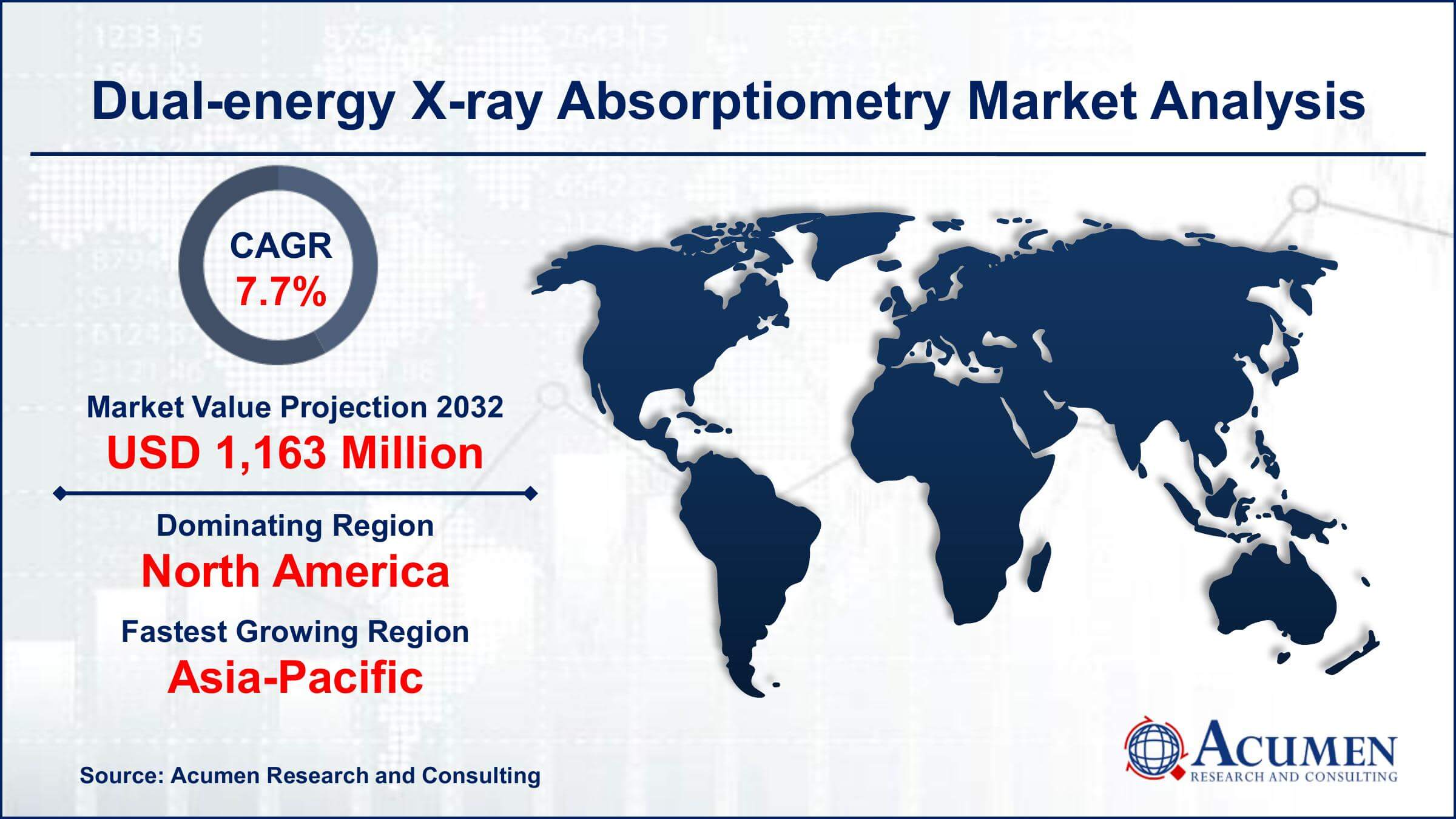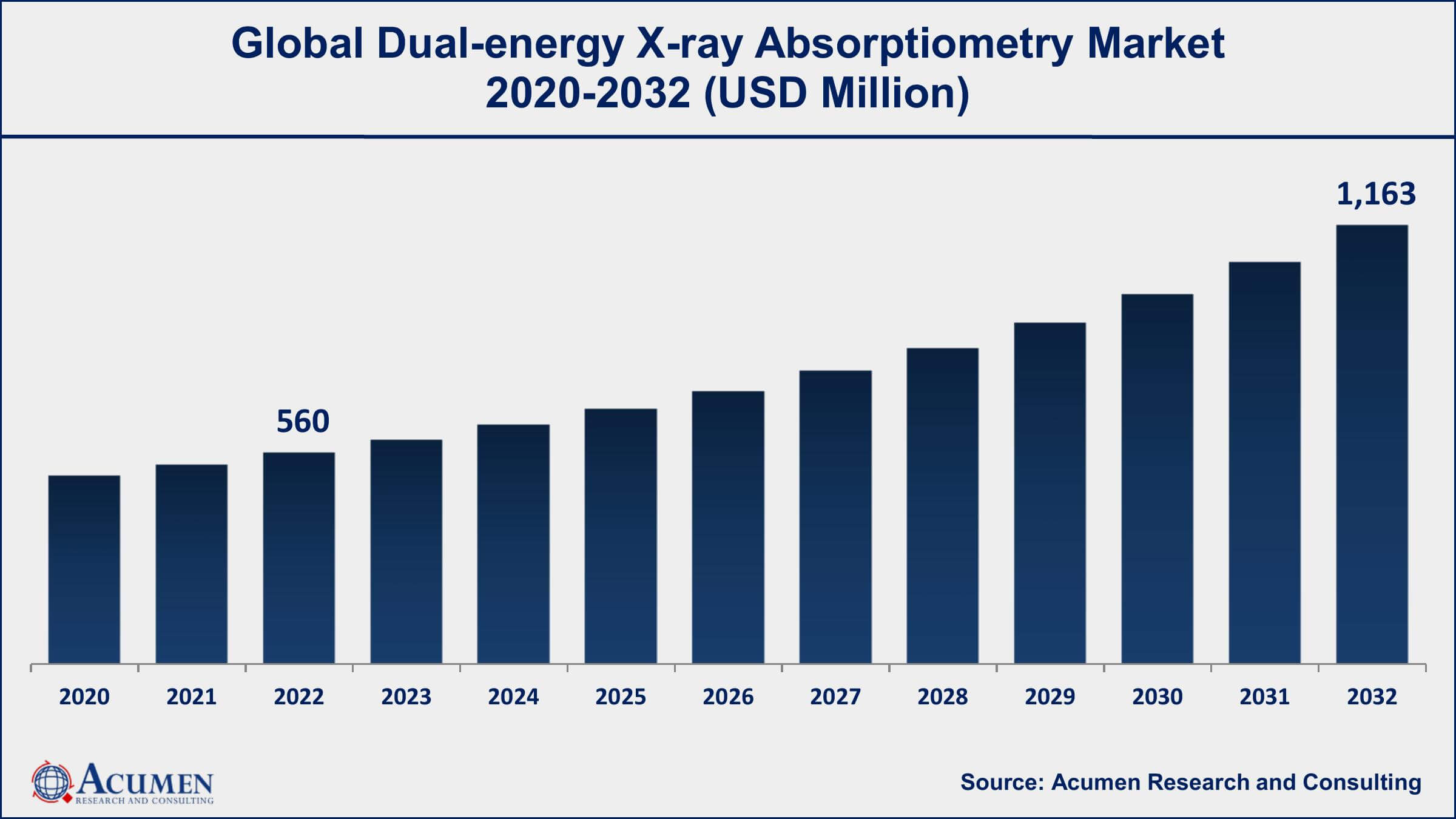July 2024
Dual energy X-ray Absorptiometry Market Size accounted for USD 560 Million in 2022 and is projected to achieve a market size of USD 1,163 Million by 2032 growing at a CAGR of 7.7% from 2023 to 2032.
The Global Dual-energy X-ray Absorptiometry (DEXA) Market Size accounted for USD 560 Million in 2022 and is projected to achieve a market size of USD 1,163 Million by 2032 growing at a CAGR of 7.7% from 2023 to 2032.
Dual-energy X-ray Absorptiometry (DEXA) Market Highlights

Dual-energy X-ray absorptiometry (DEXA or DXA) is a widely used medical imaging technique that measures bone mineral density (BMD) and body composition, including fat and lean mass. It works by passing two X-ray beams of different energy levels through the bone or body tissue. The amount of X-ray absorbed by the tissue is measured by detectors, allowing the calculation of bone mineral density and composition. DEXA scans are primarily used to diagnose osteoporosis, assess the risk of fractures, and monitor changes in bone density over time. In addition to its applications in bone health, DEXA is also utilized in the field of body composition analysis for evaluating obesity, assessing muscle mass, and guiding fitness and nutrition programs.
The market for dual-energy X-ray absorptiometry has been steadily growing over the years due to the increasing prevalence of osteoporosis and other bone-related disorders, coupled with the rising awareness about the importance of early diagnosis and management of these conditions. Additionally, the growing emphasis on preventive healthcare and the aging population worldwide have contributed to the demand for DEXA scans. Advancements in technology, such as the development of portable and more efficient DEXA machines, have further expanded the market by making the procedure more accessible and convenient for both patients and healthcare providers. Moreover, ongoing research and development activities in the field of bone health and body composition analysis are likely to introduce innovative applications of DEXA, fueling market growth in the coming years.

Global Dual-energy X-ray Absorptiometry Market Trends
Market Drivers
Market Restraints
Market Opportunities
Dual-energy X-ray Absorptiometry Market Report Coverage
| Market | Dual-energy X-ray Absorptiometry Market |
| Dual-energy X-ray Absorptiometry Market Size 2022 | USD 560 Million |
| Dual-energy X-ray Absorptiometry Market Forecast 2032 | USD 1,163 Million |
| Dual-energy X-ray Absorptiometry Market CAGR During 2023 - 2032 | 7.7% |
| Dual-energy X-ray Absorptiometry Market Analysis Period | 2020 - 2032 |
| Base Year |
2022 |
| Forecast Data | 2023 - 2032 |
| Segments Covered | By Technology, By Type, By Application, By End-use, And By Geography |
| Regional Scope | North America, Europe, Asia Pacific, Latin America, and Middle East & Africa |
| Key Companies Profiled | GE Healthcare, OSTEOSYS, Hologic, Inc., Medilink International, Swissray Medical AG, BeamMed Ltd., Osteometer Meditech Inc., Furuno Electric Co., Ltd., Medonica Co., Ltd., Scanflex Healthcare AB, Fonar Corporation, and Shenzhen XRAY Electric Co., Ltd. |
| Report Coverage |
Market Trends, Drivers, Restraints, Competitive Analysis, Player Profiling, Covid-19 Analysis, Regulation Analysis |
Dual-energy X-ray absorptiometry (DEXA or DXA) is a non-invasive medical imaging technique used to measure bone mineral density (BMD) and body composition. It operates by directing two X-ray beams with different energy levels through the body or specific bones of interest. These X-rays are absorbed differently by bones, fat, and lean tissue. Detectors measure the amount of X-rays that pass through the body, allowing for the calculation of BMD, fat mass, lean mass, and other important parameters. DEXA scans are primarily employed to diagnose osteoporosis, a condition characterized by reduced bone density and increased risk of fractures. It is also used to assess the risk of fractures in postmenopausal women and older men, monitor changes in bone density over time, and evaluate body composition for purposes such as assessing obesity, muscle mass, and overall fitness levels.
The dual-energy X-ray absorptiometry (DEXA) market has experienced significant growth in recent years and is expected to continue its upward trajectory. One of the primary drivers behind this growth is the increasing prevalence of osteoporosis and bone-related disorders, especially among the aging population. As the global demographic shifts towards an older age group, there is a higher demand for accurate and early diagnosis of bone health issues. DEXA scans play a crucial role in diagnosing osteoporosis, assessing fracture risk, and monitoring bone density changes over time. This rising demand for bone density measurement tools fuels the growth of the DEXA market.
Furthermore, technological advancements have been a key factor in propelling market growth. The development of more efficient and portable DEXA machines has made the procedure more accessible and convenient for both patients and healthcare providers. These advancements not only enhance the overall patient experience but also encourage healthcare facilities to invest in these sophisticated diagnostic tools, thereby contributing to market expansion.
Dual-energy X-ray Absorptiometry Market Segmentation
The global dual-energy x-ray absorptiometry (DEXA) market segmentation is based on technology, type, application, end-use, and geography.
Dual-energy X-ray Absorptiometry Market By Technology
According to the dual-energy x-ray absorptiometry industry analysis, the axial DEXA bone densitometer segment accounted for the largest market share in 2022. Axial DEXA bone densitometers are specialized machines that focus on assessing bone density in specific areas of the body, such as the spine and hips. These segments of the body are particularly prone to fractures due to osteoporosis, making them critical areas for diagnosis and monitoring. The increasing prevalence of osteoporosis, especially among the elderly population, has significantly contributed to the demand for axial DEXA bone densitometers. As the aging demographic expands globally, the need for accurate and efficient diagnosis of osteoporosis-related conditions has driven healthcare facilities to invest in advanced imaging technologies like axial DEXA, thereby fueling the market growth.
Dual-energy X-ray Absorptiometry Market By Type
In terms of types, the standalone segment is expected to witness significant growth in the coming years. Standalone DEXA systems refer to those devices that operate independently, without the need for integration into other imaging modalities or systems. This standalone approach offers several advantages, including flexibility, ease of use, and cost-effectiveness. Healthcare facilities, especially smaller clinics and private practices, prefer standalone DEXA systems because they provide accurate bone density measurements and body composition analysis without requiring substantial investments in additional equipment or infrastructure. One of the key factors driving the growth of the standalone segment is the increasing demand for point-of-care diagnostics. Standalone DEXA systems enable healthcare providers to perform quick and efficient bone density scans directly at the patient's location, allowing for immediate assessment and timely intervention.
Dual-energy X-ray Absorptiometry Market By Application
According to the dual-energy x-ray absorptiometry market forecast, the osteoporosis segment is expected to witness significant growth in the coming years. Osteoporosis, a condition characterized by low bone density and increased risk of fractures, primarily affects the elderly population but can also impact younger individuals due to various factors such as hormonal imbalances, nutritional deficiencies, and a sedentary lifestyle. With the global population aging and increasing awareness of osteoporosis-related risks, there has been a growing demand for accurate and early diagnosis. DEXA scans are considered the gold standard for measuring bone mineral density and diagnosing osteoporosis. As a result, healthcare providers are increasingly relying on DEXA technology to assess bone health, predict fracture risks, and initiate timely interventions, driving the growth of the osteoporosis segment in the DEXA market.
Dual-energy X-ray Absorptiometry Market By End-use
Based on the end-use, the hospitals & clinics segment is expected to continue its growth trajectory in the coming years. This growth is primarily driven by the increasing prevalence of osteoporosis and the rising awareness about the importance of bone health. Hospitals and clinics are pivotal healthcare institutions where a large number of patients, including the elderly population, seek medical care and diagnostic services. As osteoporosis is a common condition among the elderly, hospitals and clinics often utilize DEXA technology for accurate diagnosis and monitoring. The growing emphasis on early detection and preventive healthcare measures has led to an upswing in the number of DEXA scans performed in these settings. Additionally, the availability of skilled healthcare professionals and advanced infrastructure in hospitals and clinics ensures the proper administration and interpretation of DEXA scans, further boosting the demand for these services in this segment.
Dual-energy X-ray Absorptiometry Market Regional Outlook
North America
Europe
Asia-Pacific
Latin America
The Middle East & Africa
Dual-energy X-ray Absorptiometry Market Regional Analysis
North America has emerged as a dominating region in the dual-energy X-ray absorptiometry (DEXA) market due to a combination of robust healthcare infrastructure, increasing prevalence of osteoporosis, and significant investments in advanced medical technologies. The region boasts well-established healthcare systems, comprising numerous hospitals, clinics, and diagnostic centers equipped with state-of-the-art medical equipment. This infrastructure provides a conducive environment for the widespread adoption of DEXA technology. Moreover, the region's aging population, coupled with a proactive approach to preventive healthcare, has led to a growing demand for osteoporosis diagnosis and management. As osteoporosis becomes a major health concern, healthcare providers in North America are increasingly relying on DEXA scans for accurate bone density assessments, fracture risk predictions, and early interventions. Furthermore, North America is home to several leading medical device companies and research institutions, driving continuous innovation in the field of DEXA technology. These innovations include the development of more compact, user-friendly, and precise DEXA devices. The presence of a skilled workforce and substantial investments in research and development contribute to the region's leadership in technological advancements, making North America a hub for cutting-edge DEXA solutions.
Dual-energy X-ray Absorptiometry Market Player
Some of the top Dual-energy X-ray Absorptiometry Market companies offered in the professional report include GE Healthcare, OSTEOSYS, Hologic, Inc., Medilink International, Swissray Medical AG, BeamMed Ltd., Osteometer Meditech Inc., Furuno Electric Co., Ltd., Medonica Co., Ltd., Scanflex Healthcare AB, Fonar Corporation, and Shenzhen XRAY Electric Co., Ltd.
Looking for discounts, bulk pricing, or custom solutions? Contact us today at sales@acumenresearchandconsulting.com
July 2024
November 2022
February 2021
October 2022